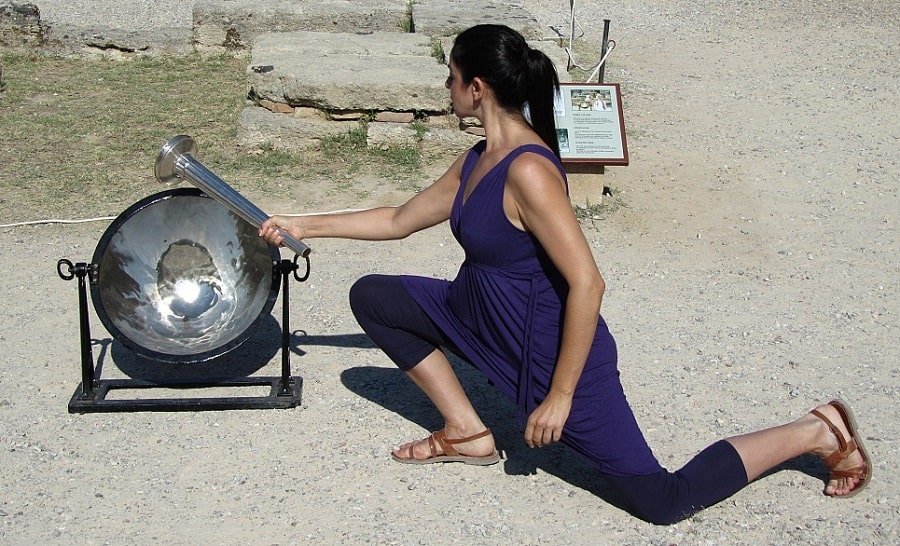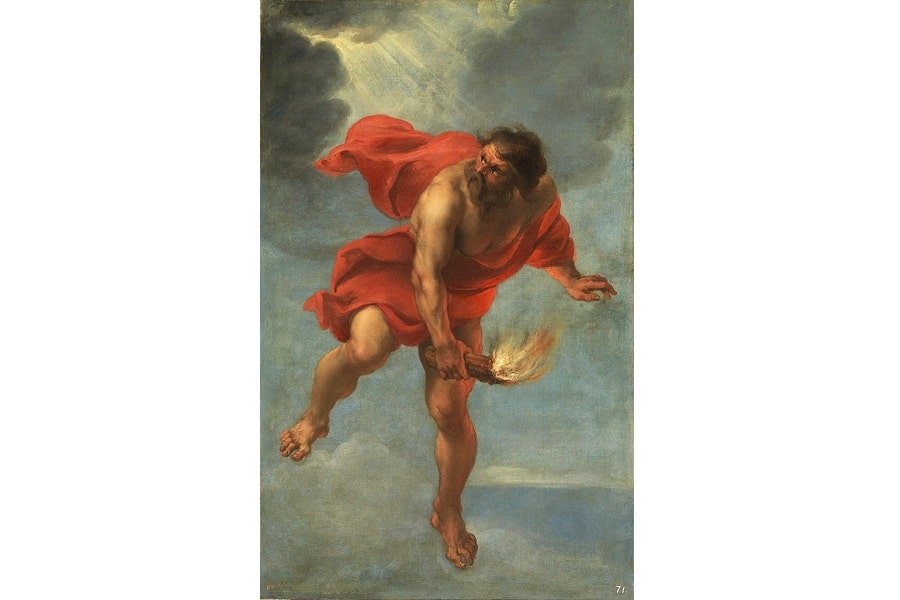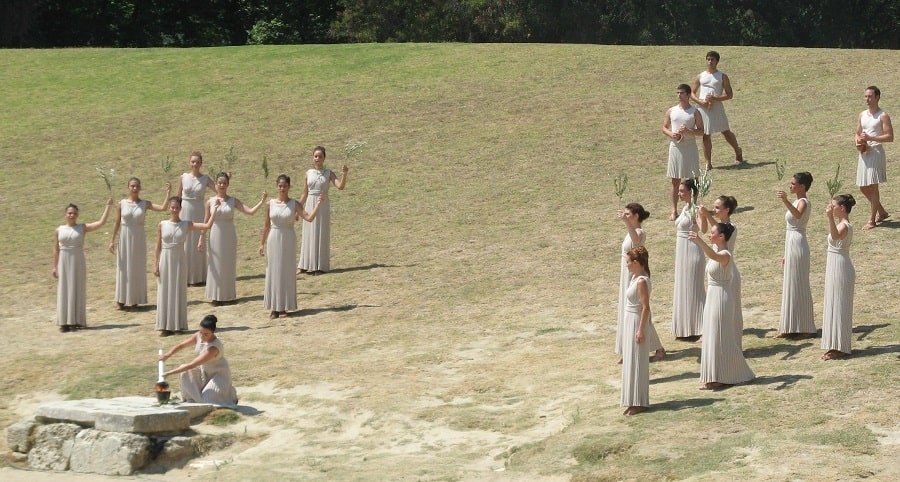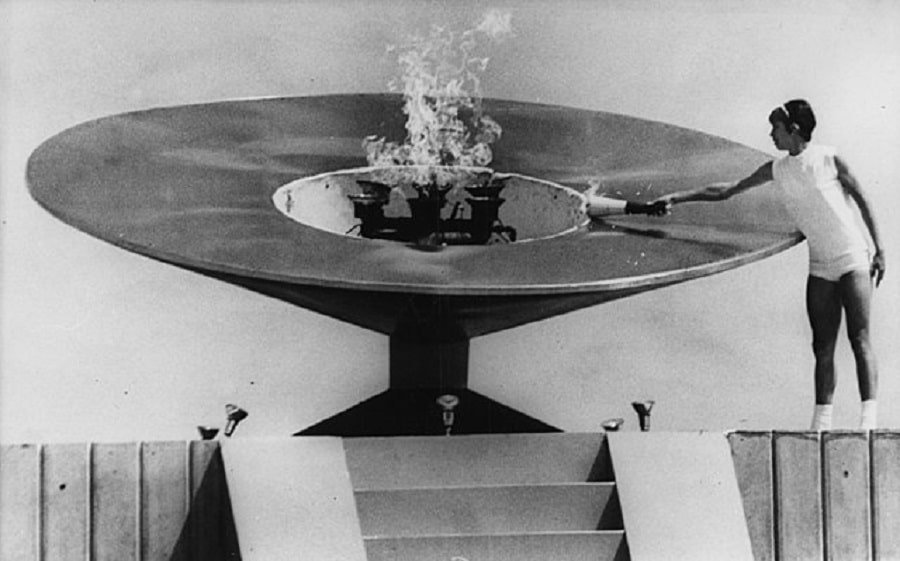The Olympic torch is one of the most important symbols of the Olympic Games and is lit in Olympia, Greece, several months before the beginning of the games. This starts the Olympic torch relay and the flames are then ceremonially carried to the host city for the opening ceremony of the Olympic Games. The torch is meant to be a symbol of hope, peace, and unity. The lighting of the Olympic torch has its roots in ancient Greece but is itself a quite recent phenomenon.
Table of Contents
What is the Olympic Torch and Why is It Lit?

The Olympic Torch is one of the most significant symbols of the Olympic Games and it has been around the world several times and has been carried by hundreds of the most renowned athletes in the world. It has traveled by every form of transport we can imagine, visited numerous countries, scaled the tallest mountains, and visited space. But has all of this happened? Why does the Olympic Torch exist and why is it lit before every Olympic Games?
The lighting of the Olympic Torch is meant to be the start of the Olympic Games. Interestingly enough, the Olympic Flame first appeared in the 1928 Amsterdam Olympics. It was lit at the top of a tower that overlooked the Olympic stadium that year, presiding over the sports and athletics that took place in the stadium. It definitely harked back to the importance of fire in rituals in ancient Greece. However, the lighting of the torch is not really a tradition that has been carried over the centuries into the modern world. The Olympic torch is very much a modern construct.
The flame is lit in Olympia in Greece. The small town on the Peloponnese peninsula is named after and famous for the nearby archaeological ruins. The site was both a major religious sanctuary and the place where the ancient Olympic Games were held every four years during classical antiquity. Thus, the fact that the Olympic flame is always lit here is very symbolic.
Once the flames are lit, it is then carried to the host country of that year’s Olympics. Most of the time, extremely famous and respected athletes carry the torch in the Olympic torch relay. The Olympic flame is finally brought to the opening of the Games and used to light the Olympic cauldron. The Olympic cauldron burns for the duration of the Games, being extinguished at the closing ceremony and waiting to be lit again in another four years.
What Does the Torch Lighting Symbolize?
The Olympic flame and the torch that carries the flame are symbolic in every single way. Not only are they a signal for the beginning of the Olympic Games that year, but the fire itself also has very definite meanings.
The fact that the lighting ceremony takes place in Olympia is to link the modern games to the ancient ones. It is a connection between past and present. It is meant to show that the world may carry on and evolve but some things about humanity will never change. Games, athletics, and the sheer joy of that kind of recreation and competitiveness are universal human experiences. The ancient games may have featured different kinds of sports and equipment but the Olympics in their essence have not changed.
Fire is meant to symbolize knowledge and life in many different cultures. Without fire, there would not have been human evolution as we know it. The Olympic flame is no different. It symbolized the light of life and spirit and a search for knowledge. The fact that it is passed from one country to another and carried by athletes all over the world is meant to represent unity and harmony.
For these few days, most countries of the world come together to celebrate a global event. The games, and the flame that represents it, are meant to go beyond the boundaries of nations and cultures. They depict oneness and peace between all humankind.

Historic Origins of the Torch
As stated above, the lighting of the Olympic flame only goes back to the 1928 Amsterdam Olympics. It was lit in a large bowl at the top of the Marathon Tower by an employee of the Electric Utility of Amsterdam. Thus, we can see, it was not quite the romanticized spectacle that it is today. It was meant to be an indication of where the Olympics were being held to everyone for miles around. The idea of this fire can be attributed to Jan Wils, the architect who designed the stadium for that particular Olympics.
Four years later, at the 1932 Los Angeles Olympics, the tradition was continued. It presided over the Los Angeles Olympic Stadium from the top of the gateway to the arena. The gateway had been made to look like the Arc de Triomphe in Paris.
The entire idea of the Olympic flame, although it was not called that at the time, came from the ceremonies in ancient Greece. In the ancient games, a sacred fire was kept burning for the duration of the Olympics on the altar at the sanctuary of the goddess Hestia.
READ MORE: 41 Greek Gods and Goddesses: Family Tree and Fun Facts
The ancient Greeks believed that Prometheus had stolen fire from the gods and presented it to humans. Thus, the fire had divine and sacred connotations. Many Greek sanctuaries, including the one at Olympia, had sacred fires in several of the altars. The Olympics were performed every four years in honor of Zeus. Fires were lit at his altar and at the altar of his wife Hera. Even now, the modern Olympic flame is lit before the ruins of Hera’s temple.
The Olympic torch relay, however, did not begin until the next Olympics in 1936. And the beginnings of it are pretty dark and controversial. It raises the question of why we have continued to appropriate a ritual that was begun in Nazi Germany mainly as propaganda.

Modern Origins of the Torch Relay
The Olympic torch relay first took place at the 1936 Berlin Olympics. It was the brainchild of Carl Diem, who was the chief organizer of the Olympics that year. Sports historian Philip Barker, who wrote the book The Story of the Olympic Torch, stated that there is no evidence that there was any kind of torch relay during the ancient games. But there might have been a ceremonial fire burning at the altar.
The first Olympic flame was transported 3187 kilometers or 1980 miles between Olympia and Berlin. It traveled overland through cities like Athens, Sofia, Budapest, Belgrade, Prague, and Vienna. Carried by 3331 runners and passed from hand to hand, the flame’s journey took almost 12 whole days.
Onlookers in Greece are said to have stayed awake waiting for the torch to go by since it happened at night. There was great excitement and it really captured the imagination of the people. There were minor protests in Czechoslovakia and Yugoslavia on the way, but local law enforcement quickly suppressed them.
The first torchbearer during that maiden event was the Greek Konstantinos Kondylis. The final torchbearer was the German runner Fritz Schilgen. The blonde-haired Schilgen was said to be chosen for his ‘Aryan’ appearance. He lit the Olympic cauldron from the torch for the very first time. The footage for the torch relay was restaged and reshot several times and turned into a propaganda film in 1938, called Olympia.
Supposedly, the torch relay was meant to be based on a similar ceremony from ancient Greece. There is very little evidence that this kind of ceremony ever existed. It was essentially propaganda, comparing Nazi Germany with the great ancient civilization of Greece. The Nazis thought of Greece as an Aryan predecessor of the German Reich. The 1936 Games were also dogged by racist Nazi newspapers filled with commentary about the Jewish and non-white athletes. Thus, as we can see, this modern symbol of international harmony actually has extremely nationalistic and rather unsettling origins.
There were no Olympics until after World War II since the 1940 Tokyo Olympics and 1944 London Olympics were canceled. The torch relay might have died out after its maiden voyage, due to the circumstances of the war. However, in the first post-World War II Olympics, held in London in 1948, the organizers decided to continue the torch relay. Perhaps they meant it as a sign of unity for the recovering world. Perhaps they thought it would make for good publicity. The torch was carried all the way, on foot and by boat, by 1416 torchbearers.
The Olympic torch relay of 1948 had people tuning in at 2 am and 3 am to watch. England was in a bad state at the time and still rationing. The fact that it was hosting the Olympics at all was remarkable. And a spectacle like the torch relay at the opening ceremony helped lift the spirits of the people. The tradition has continued since then.

The Main Ceremonies
From the lighting ceremony in Olympia to the moment that the Olympic cauldron is extinguished in the closing ceremony, there are several rituals involved. The flame’s journey can take anywhere from days to months to complete. Backup flames are kept in a miner’s lamp and carried alongside the Olympic torch, in case of emergencies.
The Olympic torch is used for both the Summer and Winter Olympics. It meant the torch eventually became airborne, as it traveled across various continents and around both hemispheres. There have been mishaps and stunts aplenty. For example, the 1994 Winter Olympics were to see the torch skied down a slope before lighting the Olympic cauldron. Unfortunately, the skier Ole Gunnar Fidjestøl broke his arm in a practice run and the job had to be entrusted to someone else. This is far from the only such tale.
The Lighting of the Flame
The lighting ceremony takes place sometime prior to the opening ceremony of that year’s Olympics. In the lighting ceremony, eleven women representing the Vestal Virgins light the fire with the help of a parabolic mirror at the Temple of Hera in Olympia. The flame is lit by the sun, concentrating its rays in the parabolic mirror. This is meant to represent the blessings of the sun god Apollo. A backup flame is usually also lit in advance, just in case the Olympic flame goes out.
READ MORE: Sun Gods: Ancient Solar Deities From Around the World
The woman acting as head priestess then hands the Olympic torch and an olive branch to the first torchbearer. This is usually a Greek athlete who is to participate in the Games that year. There is a recitation of a poem by Pindar and a dove is released as a symbol of peace. The Olympic hymn, the national anthem of Greece, and the national anthem of the host country are sung. This concludes the lighting ceremony.
After this, the Hellenic Olympic Committee transfers the Olympic flame to the National Olympic Committee of that year in Athens. This begins the Olympic torch relay.

The Torch Relay
During the Olympic torch relay, the Olympic flame usually travels the routes that best symbolize human achievement or the history of the host country. Depending on the location of the host country, the torch relay can take place on foot, in the air, or on boats. The torch relay has become something of a pageant in recent years, with every country attempting to outdo previous records.
In 1948, the torch traveled across the English Channel by boat, a tradition that was continued in 2012. Rowers also carried the torch in Canberra. In Hong Kong in 2008 the torch traveled by dragon boat. The first time it traveled by airplane was in 1952 when it went to Helsinki. And in 1956, the flame arrived for the equestrian events in Stockholm on horseback (since the main Games took place in Melbourne).
Things were taken up a notch in 1976. The flame was transferred from Europe to the Americas as a radio signal. Heat sensors in Athens detected the flame and sent it to Ottawa via satellite. When the signal arrived in Ottawa, it was used to trigger a laser beam to relight the flame. Astronauts even took the torch, if not the flame, to space in the years 1996, 2000, and 2004.
A diver carried the flame across the port of Marseilles in the 1968 Winter Olympics by holding it above the water. An underwater flare was used by a diver traveling over the Great Barrier Reef for the 2000 Sidney Olympics.
READ MORE: Who Invented Water? History of the Water Molecule
Whatever the means employed, the flame finally has to make it to the Olympic stadium for the opening ceremony. This takes place in the central host stadium and ends with the torch being used to light the Olympic cauldron. It is usually one of the most famous athletes of the hosting country that is the final torchbearer, as has become the tradition over the years.
In the most recent Summer Olympics, during the Covid-19 pandemic, there was no opportunity for dramatics. The flame arrived in Tokyo via airplane for the opening ceremony. While there were several runners who passed the flame on from one to the other, the usual large crowd of spectators was missing. Past torches had traveled by parachute or camel but this last ceremony was mainly a series of isolated events within Japan.
The Igniting of the Cauldron
The Olympics opening ceremony is an extravaganza that is widely filmed and watched. It features different kinds of performances, a parade by all the participating nations, and the last leg of the relay. This finally culminates in the lighting of the Olympic cauldron.
During the opening ceremony, the final torchbearer runs through the Olympic stadium towards the Olympic cauldron. This is often placed at the top of a grand staircase. The torch is used to start a flame in the cauldron. This symbolizes the official beginning of the games. The flames are meant to burn until the closing ceremony when they are formally extinguished.
The final torchbearer may not be the most famous athlete in the country every time. Sometimes, the person who lights the Olympic cauldron is meant to symbolize the values of the Olympic Games itself. For example, in 1964, Japanese runner Yoshinori Sakai was chosen to light the cauldron. Born on the day of the Hiroshima bombing, he was chosen as a symbol of Japan’s healing and resurrection and a wish for global peace.
In 1968, Enriqueta Basilio became the first woman athlete to light the Olympic Cauldron at the Games in Mexico City. The first well-known champion to be entrusted with the honor was probably Paavo Nurmi of Helsinki in 1952. He was a ninefold Olympic winner.
There have been several jaw-dropping lighting ceremonies over the years. In the 1992 Barcelona Olympics, Paralympic archer Antonio Rebollo shot a burning arrow over the cauldron to light it. In the 2008 Beijing Olympics, gymnast Li Ning ‘flew’ around the stadium on wires and lit the cauldron on the roof. At the 2012 London Olympics, rower Sir Steve Redgrave carried the torch to a group of young athletes. They each lit a single flame on the ground, igniting 204 copper petals that converged to form the Olympic cauldron.

How Does the Olympic Torch Stay Lit?
Since the very first lighting ceremony, the Olympic flame has traveled through air and water and over hundreds and thousands of kilometers. One might ask how it’s possible that the Olympic torch remains lit through all of it.
There are several answers. Firstly, the modern torches used during the Summer and Winter Olympics are built to resist the effects of rain and wind as much as possible as they carry the Olympic flame. Secondly, what is important to note is that it is not one torch that is used throughout the torch relay. Hundreds of torches are used and the relay runners can even buy their torch at the end of the race. Hence, symbolically, it is the flame that actually matters in the torch relay. It is the flame that is passed on from one torch to another and that needs to stay lit the entire time.
However, that does not mean that accidents do not take place. The flame can go out. When that happens, there is always a backup flame lit from the original flame in Olympia to replace it. As long as the flame was symbolically lit in Olympia with the help of the sun and a parabolic mirror, that is all that matters.
Still, torchbearers remain prepared for the circumstances they will face. There are specially designed containers that protect the flame and the backup flame when traveling by airplane. In 2000, when the Olympic torch traveled underwater to Australia, an underwater flare was utilized. It does not matter if the flame has to be relit once or twice during its journey. What matters most is that it keeps burning in the Olympic cauldron from the opening ceremony to the moment it is snuffed out in the closing ceremony.
Has the Olympic Torch Ever Gone Out?
The organizers try their utmost to keep the torch burning during the Olympic torch relay. But accidents do still happen on the road. As journalists tail the journey of the torch closely, these accidents also often come to light.
Natural disasters might have an effect on the torch relay. The 1964 Tokyo Olympics had a typhoon damage the airplane that was carrying the torch. A backup plane had to be called in and a second flame was quickly sent over to make up for lost time.
In 2014, during the Sochi Olympics in Russia, a journalist reported that the flame had gone out 44 times on its journey from Olympia to Sochi. The wind blew the torch out just moments after it was lit by Russian president Vladimir Putin at the Kremlin.
In 2016, there was a protest by government employees in Angra dos Reis in Brazil. They had not been paid their wages. Protestors stole the torch from an event and purposefully put it out just before the Rio de Janeiro Olympics. The same thing also happened in Paris during the worldwide torch relay prior to the 2008 Beijing Olympics.
A protest by a veterinary student called Barry Larkin at the 1956 Melbourne Games in Australia had the strangely opposite effect. Larkin tricked onlookers by carrying a fake torch. It was meant to be a protest against the relay. He set some undergarments on fire, placed them in a plum pudding can, and attached it to a chair leg. He even managed to successfully hand over the fake torch to the Mayor of Sidney and escaped without attracting notice.